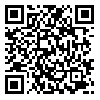BibTeX | RIS | EndNote | Medlars | ProCite | Reference Manager | RefWorks
Send citation to:
URL: http://cjns.gums.ac.ir/article-1-169-en.html
2- MSc in Cognitive Science, AzarbaijanShahidMadani University, Tabriz, Iran
Background: There are some convincing shreds of evidence indicating that memory can direct attention. The local efficiency of an area in the brain, as a quantitative feature in a complex network, indicates how the surrounding nodes can transfer the information when a specific node is omitted. This feature is a scale for measuring efficient integration of information in the brain.
Objectives: The purpose of the present study is to predict the reaction time using the local efficiency variable while doing memory-guided attention task. Materials and Methods: The fMRI database of a research done in New York University during a visual search task was used for this study. Thirty-five right-handed healthy participants (51% female, mean age= 21.7 years) were recruited at New York University. SPM was used for pre-processing fMRI images, and CONN was used for calculating the values of local efficiency. SPSS was also used for statistical analysis of the study.
Results: Results of the study revealed that local efficiency of the right hippocampus can positively predict the reaction time during memory-guided attention tasks.
Conclusion: The findings of the study demonstrated that the hippocampus area has a significant role in the performance of memory-guided attention, and this significant role of the hippocampus reveals that long-term memory uses the hippocampus and affects the movement and attention of eyes on the target.
Received: 2017/07/1 | Accepted: 2017/07/1 | Published: 2017/07/1
| Rights and permissions | |
 | This work is licensed under a Creative Commons Attribution-NonCommercial 4.0 International License. |




